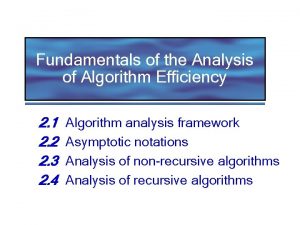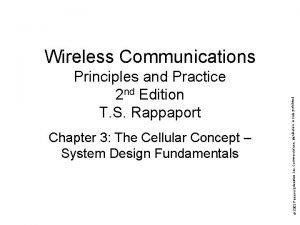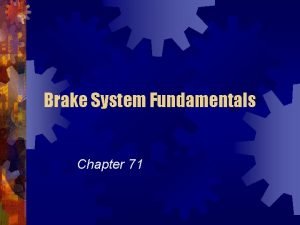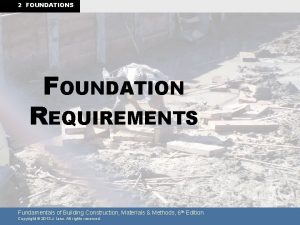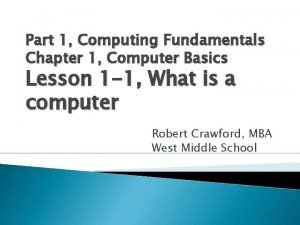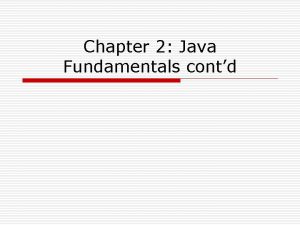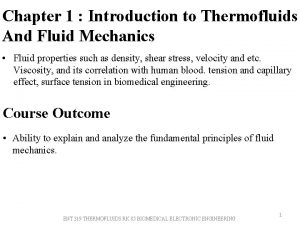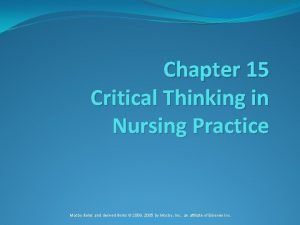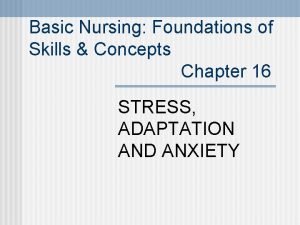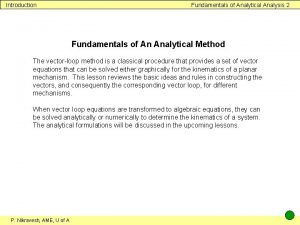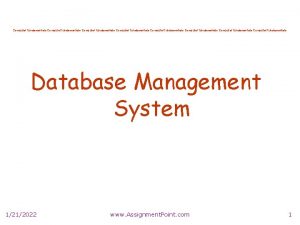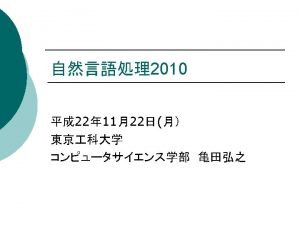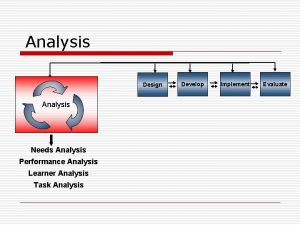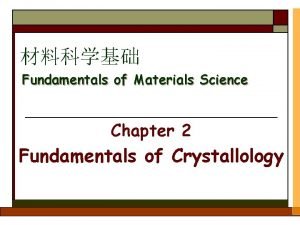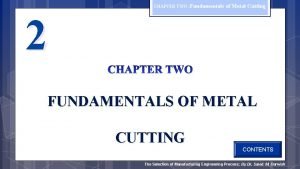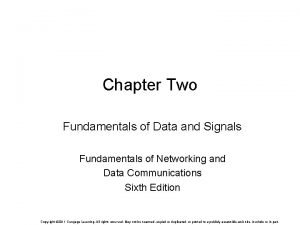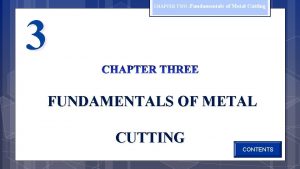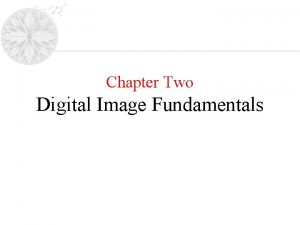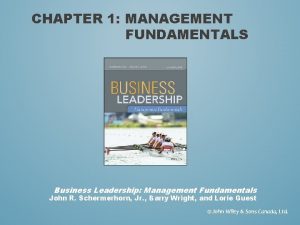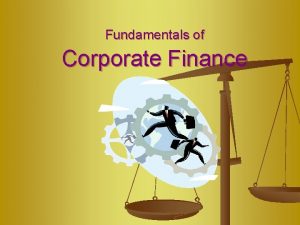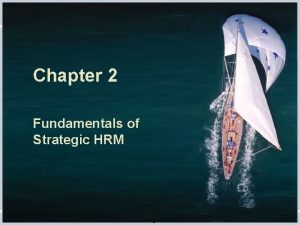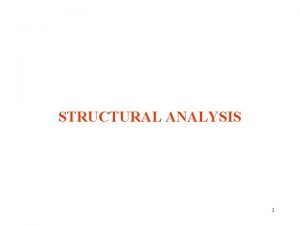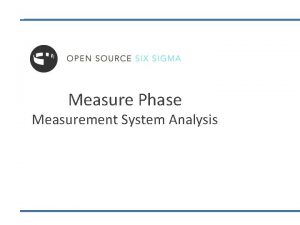1 CHAPTER 1 SYSTEM ANALYSIS FUNDAMENTALS 2 Chapter











































- Slides: 43

1 CHAPTER 1 SYSTEM ANALYSIS FUNDAMENTALS

2 Chapter Objectives • Discuss the impact of information technology on business strategy and success • Define an information system and describe its components • Explain how profiles and models can represent business functions and operations • Explain how the Internet has affected business strategies and relationships

3 Chapter Objectives • Identify various types of information systems and explain who uses them • Distinguish between structured analysis, objectoriented analysis, and agile methods • Compare the traditional waterfall model with agile methods and models • Discuss the role of the information technology department and the systems analysts who work there

4 Introduction • Companies use information as a weapon in the battle to increase productivity, deliver quality products and services, maintain customer loyalty, and make sound decisions. • Information technology can mean the difference between success and failure

5 The Impact of Information Technology • Information Technology (IT) ▫ Combination of hardware and software products and services that companies use to manage, access, communicate, and share information. ▫ Business success depends on information technology

6 The Impact of Information Technology • 3 key issues that affect the company’s strategy and operational plans: ▫ Changes in the world-lowering of trade barriers ▫ Changes in technology-new model of computing ▫ Changes in client demand-innovate-in products and services • Systems Development ▫ Business information systems are developed by people who are technically qualified, businessoriented and highly motivated. ▫ Successful developers also must be good communicators with strong analytical and critical thinking skills

7 ▫ Systems Analysis and Design Step-by-step process for developing high-quality information systems Systems Analyst-Plan, develop, and maintain information systems • Who develops Information Systems? ▫ In-house applications-develop its own information system ▫ Software packages-purchased system from outside vendors Internet-based application services Outsourcing Custom solutions Enterprise-wide software strategies ▫ Risk if How versus What (decide how the system will be constructed before determining what the system needs to do)

8 Information System Components • A system is a set of related components that produces specific results • A Mission-critical system is one that is vital to a company’s operations • Data consists of basic facts that are the system’s raw material • Information is data that has been transformed into output that is valuable to users • Information systems have five key components: hardware, software, data, processes, and people

9 Information System Components

10 Information System Components • Hardware ▫ Is the physical layer of the information system ▫ Moore’s Law-number of transistors on an integrated circuit would double about 24 months • Processes ▫ Describe the tasks and business functions that users, managers, and IT staff members perform to achieve specific results • Software ▫ Refers to the programs that control the hardware and produce the desired information or results ▫ System software ▫ Application software Enterprise applications Horizontal system Vertical system ▫ Must consider Legacy systems

11 Information System Components • People ▫ People who have interest in information system Stakeholders Users, or end users • Data ▫ Raw material that an information system transforms into useful information. ▫ Tables store data ▫ By linking the tables, the system can extract specific information

12 Understanding The Business • Business Process Modeling-represent company operations and information needs. • Business Profile-overview of company’s missions, functions, organization, products, services, customers, suppliers, competitors, constraints, and future direction. • Business Process-specific set of transactions, events and results that can be described and documented. ▫ Business process model-graphically displays one or more business processes ▫ Business process modeling notation-computer based modeling tools that use standard language

13 Business Model: Handle Sales Order Event: Receives Sales Order Process: Check customer status Process: Verify customer credit Result: Completed Sales Order Process: Enter customer order data

14 Understanding The Business New Kinds of Companies Traditionally companies identified as: ▫ Production-oriented -manufacturer ▫ Service-oriented-vendors, developers, service providers • Newest kind of company: ▫ Internet-dependent@Dot-com (. com)-its primary business depends on the internet rather than traditional business channel: Google, Yahoo • Brick-and-mortar-conduct business primarily from physical location: Wal-Mart ▫ Expanded web based marketing

15 Impact of the Internet • E-Commerce or I-Commerce-internet based systems ▫ B 2 C (Business-to-Consumer) Consumer go online to purchase a products/services Familiar to retail customers ▫ B 2 B (Business-to-Business) Use EDI Extensible markup language (XML) Online B 2 B intraction: Supplier relationship management (SRM)

16 Business Information Systems • In the past, IT managers divided systems into categories based on the user group the system served ▫ ▫ Office systems Operational systems Decision support systems Executive information systems

17 • New system definition: • Enterprise computing systems – Support company-wide operations and data management requirements – Enterprise resource planning (ERP) – Many hardware and software vendors target the enterprise computing market

18 • Transaction processing systems ▫ Involve large amounts of data and are mission-critical systems ▫ Efficient because they process a set of transaction-related commands as a group rather than individually

19 • Business support systems ▫ Provide job-related information to users at all levels of a company ▫ Management information systems (MIS) ▫ Radio frequency identification (RFID) ▫ What-if • Knowledge management systems ▫ Called expert systems ▫ Simulate human reasoning by combining a knowledge base and inference rules ▫ Many knowledge management systems use a technique called fuzzy logic

20 • User productivity systems ▫ Technology that improves productivity ▫ Groupware-run on the company intranet and enable • Information systems integration ▫ Most large companies require systems that combine transaction processing, business support, knowledge management, and user productivity features

21 Information System Users and Their Needs

22 Systems Development Tools • Modeling: graphical representation of a concept or process that systems developers can analyze, test and modify. ▫ Business model/Requirements model-describes the information that a system must provide. ▫ Data model-describes data structures and design. ▫ Object model-describes objects, which combine data and processes. ▫ Network model-describes the design and protocols of telecommunications links. ▫ Process model-describes the logic that the programmers use to write code modules.

23 Systems Development Tools • Prototyping ▫ Prototype-early working version of an information system ▫ Speeds up the development process significantly ▫ Disadvantage-Important decisions might be made too early, before business or IT issues are thoroughly understood ▫ Can be an extremely valuable tool

24 Systems Development Tools • Computer-Aided Systems Engineering (CASE) Tools ▫ Also called computer-aided software engineering ▫ A technique that use CASE tools to help system analyst develop and maintain information systems. ▫ Can generate program code, which speeds the implementation process

25 Systems Development Methods • Structured Analysis ▫ Uses a series of phases called Systems development life cycle (SDLC) ▫ Predictive approach-based on overall plan ▫ Uses a set of process models to describe a system graphically ▫ Process-centered technique-focuses on processes that transform data into useful information ▫ Waterfall model

26 ▫ Deliverable or end product –result of each phase ▫ Disadvantage in the built-in structure of the SDLC, because the waterfall model does not emphasize interactivity among the phases ▫ This criticism can be valid if the SDLC phases are followed too rigidly ▫ Adjacent phases usually interact ▫ The SDLC model usually includes five steps: Systems planning Systems analysis Systems design Systems implementation Systems support and security

27 ▫ Systems Planning Systems planning phase begin with Systems request –describes problems or desired changes Purpose of this phase is to perform a preliminary investigation-to evaluate an IT related business opportunity or problem. Key part of preliminary investigation is a feasibility study-reviews anticipated cost and benefit and recommends a course of action based on operational, technical, economic and tie factors

28 ▫ Systems Analysis To build a logical model of the new system First step is requirements modeling-investigate business processes and document what the new system must do to satisfy users. Perform fact finding Deliverable is the System requirements document-describes management and user requirements, costs and benefits and outlines alternative development strategies. ▫ Systems Design To create a physical model that will satisfy all documented requirements for the system Deliverable is system design specification Management and user involvement is critical to avoid misunderstanding

29 ▫ Systems Implementation New system is constructed The objective is to deliver a completely functioning and documented information system Include an assessment called system evaluation-to determine whether the system operates properly and if costs and benefits are within expectation ▫ Systems Support and Security IT staff maintains, enhances and protects the system A well-designed system must be secure, reliable, maintainable, and scalable-can expand to meet new business requirements and volumes Most information systems need to be updated significantly or replaced after several years of operation

30 The phases and deliverables of the SDLC Phase 1 Systems Planning Preliminary Investigation Report Phase 2 Systems Analysis System Requirements Document Phase 3 Systems Design Operational Information System Phase 4 Systems implementation Complete Functioning Information system Phase 5 Systems Support and security System Design Specification

31 • Object-oriented Analysis – Combines data & processes that act on the data into things called objects – Object is a member of a class – Objects possess properties – Methods change an object’s properties

32 ▫ A message requests specific behavior or information from another object ▫ Usually follow a series of analysis and design phases that are similar to the SDLC ▫ Interactive model-can accurately depict real world business processes. Planning De sig is n g tin Tes An s aly An interactive model often is used with OO development method. Planning analysis and design tasks interact continuously e pro t yp

33 • Agile Methods ▫ Are the newest development ▫ Emphasizes continuous feedback ▫ Iterative development ▫ Agile community has published the Agile Manifesto ▫ Use Spiral model-represents a series of iterations or revisions based on user feedback ▫ Agile process determines the end result ▫ Other adaptive variations and related methods exist ▫ Two examples are Scrum and Extreme Programming (XP) ▫ Analysts should understand the pros and cons of any approach before selecting a development method

34 Typical phases and tasks in a spiral model PHASE TASKS Planning Define objectives, constraints and deliverables Risk analysis Identify risks and develop acceptable resolutions Engineering Develop a prototype that includes all deliverables Evaluation Perform assessment and testing to develop objectives for next iteration

35 • Other Development Methods ▫ Joint application development (JAD) ▫ Rapid application development (RAD) ▫ Might encounter other systems development techniques ▫ Rational Unified Process (RUP®) ▫ Microsoft Solutions Framework (MSF)

36 Systems Development Guidelines 5 Basic Systems Development Guidelines Develop a project plan Prepare an overall project plan and stick to it. Complete the task in a logical sequence. Develop a clear set of ground rules and be sure that everyone on the team understands them clearly Involve users and listen carefully to them Ensure that users are involved in the development process, especially when identifying and modeling system requirements. Use project management tools to identify tasks and milestones Try to keep the project on track and avoid surprises. Develop accurate cost and benefit information Managers need to know the cost to developing and operating system, and the value of the benefits it will provide. Remain flexible Flexible with the framework.

37 Information Technology Department

38 The Systems Analyst Position • Responsibilities – Translate business requirements into IT projects • Required Skills and Background – Solid technical knowledge, strong oral and written communication skills and analytic ability, and an understanding of business operations and processes • Certification – Important credential

39 The Systems Analyst Position • Career Opportunities ▫ What is important for you to consider: Job titles Company organization Company size Corporate culture Salary, location, and future growth

40 Chapter Summary • IT refers to the combination of hardware and software resources that companies use to manage, access, communicate, and share information • The essential components of an information system are hardware, software, data, processes, and people • Most companies offer a mix of products, technical and financial services, consulting, and customer support

41 Chapter Summary • Systems analyst use modeling, prototyping, and computer aided systems engineering (CASE) tools • Three popular system development approaches are structured analysis, object-oriented analysis (O-O), and agile methods, also called adaptive methods • Regardless of the development strategy, people, tasks, timetables, and cost must be managed effectively using project management tools

42 Chapter Summary • The IT department develops, maintains and operates a company’s information systems • Systems analysts need a combination of technical and business knowledge, analytical ability, and communication skills • Systems analysts need to consider salary, location, and future growth potential when making a career decision

43 Chapter exercise: Review questions 1. What is information technology, and why is it important to a business? 2. Define business profile, processes and modeling. 3. Identify the main components of an information system. 4. Describe 5 types of information systems and give an example of each. 5. Describe 4 organizational level of a typical business and their information requirements. 6. Describe the phases of the system development life cycle. 7. What is object-oriented analysis? and how does it differ from structured analysis.
 Chapter 23 computer system fundamentals
Chapter 23 computer system fundamentals Ali sekmen
Ali sekmen Steps in mathematical analysis of non recursive algorithm
Steps in mathematical analysis of non recursive algorithm Cellular system design fundamentals
Cellular system design fundamentals Brake system fundamentals quiz 71
Brake system fundamentals quiz 71 Neural circuits the organization of neuronal pools
Neural circuits the organization of neuronal pools Fundamentals of information systems chapter 1
Fundamentals of information systems chapter 1 Sensory input and motor output
Sensory input and motor output What are neuron processes
What are neuron processes Fundamentals chapter 1
Fundamentals chapter 1 Fundamentals of electric circuits chapter 4 solutions
Fundamentals of electric circuits chapter 4 solutions Fundamentals of corporate finance chapter 6 solutions
Fundamentals of corporate finance chapter 6 solutions Digital fundamentals chapter 4
Digital fundamentals chapter 4 Chapter 24 magnetism magnetic fundamentals answers
Chapter 24 magnetism magnetic fundamentals answers Tire wheel and wheel bearing fundamentals
Tire wheel and wheel bearing fundamentals Chapter 1 understanding health and wellness answer key
Chapter 1 understanding health and wellness answer key Fundamentals of electric circuits chapter 9 solutions
Fundamentals of electric circuits chapter 9 solutions Fundamentals of electric circuits chapter 7 solutions
Fundamentals of electric circuits chapter 7 solutions Building the right foundations/fundamentals
Building the right foundations/fundamentals Chapter 1 computer fundamentals
Chapter 1 computer fundamentals Fundamentals of corporate finance chapter 1
Fundamentals of corporate finance chapter 1 Fundamentals of thermal-fluidsciences chapter 1 problem 19p
Fundamentals of thermal-fluidsciences chapter 1 problem 19p White-collar workers คือ
White-collar workers คือ Fundamentals of nursing chapter 17 vital signs
Fundamentals of nursing chapter 17 vital signs Forensic science fundamentals and investigations chapter 6
Forensic science fundamentals and investigations chapter 6 Lodging operation in hospitality industry
Lodging operation in hospitality industry Chapter 2 lab java fundamentals
Chapter 2 lab java fundamentals Back channeling nursing
Back channeling nursing Fundamentals of thermal-fluidsciences chapter 1 problem 9p
Fundamentals of thermal-fluidsciences chapter 1 problem 9p Chapter 39 electrical fundamentals
Chapter 39 electrical fundamentals Fundamentals of thermal-fluidsciences chapter 2 problem 18p
Fundamentals of thermal-fluidsciences chapter 2 problem 18p Fundamentals of thermal-fluidsciences chapter 2 problem 64p
Fundamentals of thermal-fluidsciences chapter 2 problem 64p Critical thinking model nursing
Critical thinking model nursing Chapter 1 understanding your health and wellness
Chapter 1 understanding your health and wellness Fundamentals of thermal-fluidsciences chapter 1 problem 19p
Fundamentals of thermal-fluidsciences chapter 1 problem 19p Fundamentals of thermal-fluidsciences chapter 1 problem 1p
Fundamentals of thermal-fluidsciences chapter 1 problem 1p Fundamentals of nursing chapter 16
Fundamentals of nursing chapter 16 Grashof number
Grashof number Fundamentals of corporate finance, chapter 1
Fundamentals of corporate finance, chapter 1 Fundamentals of thermal-fluidsciences chapter 2 problem 30p
Fundamentals of thermal-fluidsciences chapter 2 problem 30p Fundamentals of thermal-fluidsciences chapter 2 problem 28p
Fundamentals of thermal-fluidsciences chapter 2 problem 28p Tools for structured analysis
Tools for structured analysis Fact finding and analysis
Fact finding and analysis Technical feasibility example
Technical feasibility example


